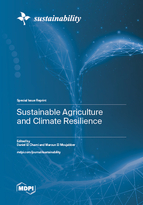Sustainable Agriculture and Climate Resilience
A special issue of Sustainability (ISSN 2071-1050). This special issue belongs to the section "Sustainable Agriculture".
Deadline for manuscript submissions: closed (26 March 2023) | Viewed by 30290
Special Issue Editors
Interests: sustainability; agrosystems; ecosystem services; natural resources management; tradeoffs; climate change; adaptation; resilience
Special Issue Information
Dear Colleagues,
Agriculture, fundamental for human survival, integrates biological, chemical, and physical processes for food and feed supply. From one side, the high dependence of agriculture on natural processes increases its vulnerability to climate variability and uncertainty. From another side, agriculture also contributes a significant share of the GHG emissions that cause climate change, drastically endangering our existence. The literature suggests sustainable agriculture as a practice to preserve our natural ecosystems and mitigate climate change. However, sustainable agriculture is still intensively debated in the scientific community, and it still has no agreed definition. In many cases, there is a misuse and misinterpretation of the concept.
If sustainability focuses on preserving our ecosystems, adaptation and resilience concentrate on protecting people from the changes brought by a changing climate to the ecosystems and allow them to absorb, withstand, and bounce back after climate adversities. Therefore, this Special Issue will publish all types of articles accepted by the journal (e.g., research, review, opinion). It will explore the interconnections and tradeoffs between different agriculture practices and ecosystems and their adaptation and resilience capability under climate change conditions.
Focus: This issue will focus on agricultural practices (including livestock production and fisheries) in all geographical locations and hydro-climatic conditions.
Scope: The scope of this issue includes investigations of the adaptation and resilience of agro-systems to climate change in terms of the interconnection between social, environmental, and economic outcomes.
Purpose: This issue aims to add to the scientific literature and show to the agro-food sector the sustainable practices that could create a balance between the three pillars of sustainability and improve social well-being, increase economic outcomes, and reduce negative environmental externalities.
Dr. Daniel El Chami
Dr. Maroun EL Moujabber
Guest Editors
Manuscript Submission Information
Manuscripts should be submitted online at www.mdpi.com by registering and logging in to this website. Once you are registered, click here to go to the submission form. Manuscripts can be submitted until the deadline. All submissions that pass pre-check are peer-reviewed. Accepted papers will be published continuously in the journal (as soon as accepted) and will be listed together on the special issue website. Research articles, review articles as well as short communications are invited. For planned papers, a title and short abstract (about 100 words) can be sent to the Editorial Office for announcement on this website.
Submitted manuscripts should not have been published previously, nor be under consideration for publication elsewhere (except conference proceedings papers). All manuscripts are thoroughly refereed through a single-blind peer-review process. A guide for authors and other relevant information for submission of manuscripts is available on the Instructions for Authors page. Sustainability is an international peer-reviewed open access semimonthly journal published by MDPI.
Please visit the Instructions for Authors page before submitting a manuscript. The Article Processing Charge (APC) for publication in this open access journal is 2400 CHF (Swiss Francs). Submitted papers should be well formatted and use good English. Authors may use MDPI's English editing service prior to publication or during author revisions.
Keywords
- Sustainability
- Agrosystems
- Ecosystems
- Tradeoffs
- Resilience
- Adaptation
- Scenarios
- Climate change







